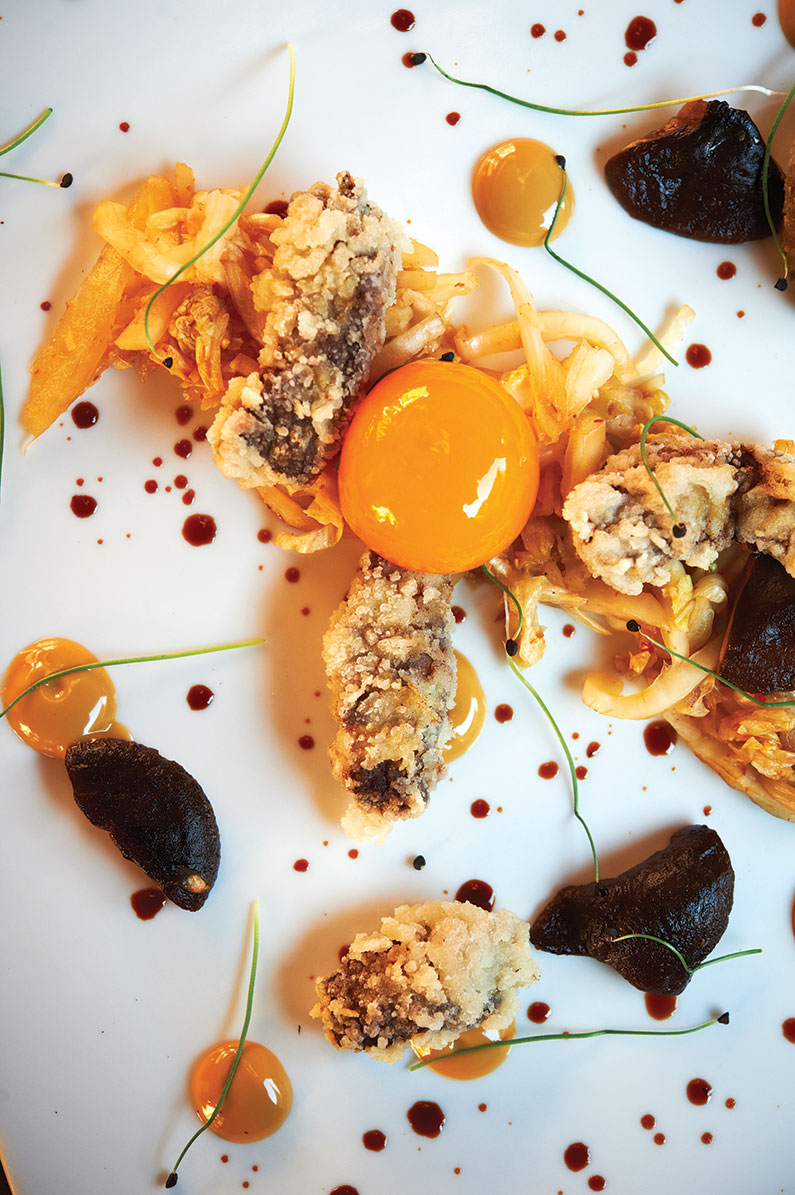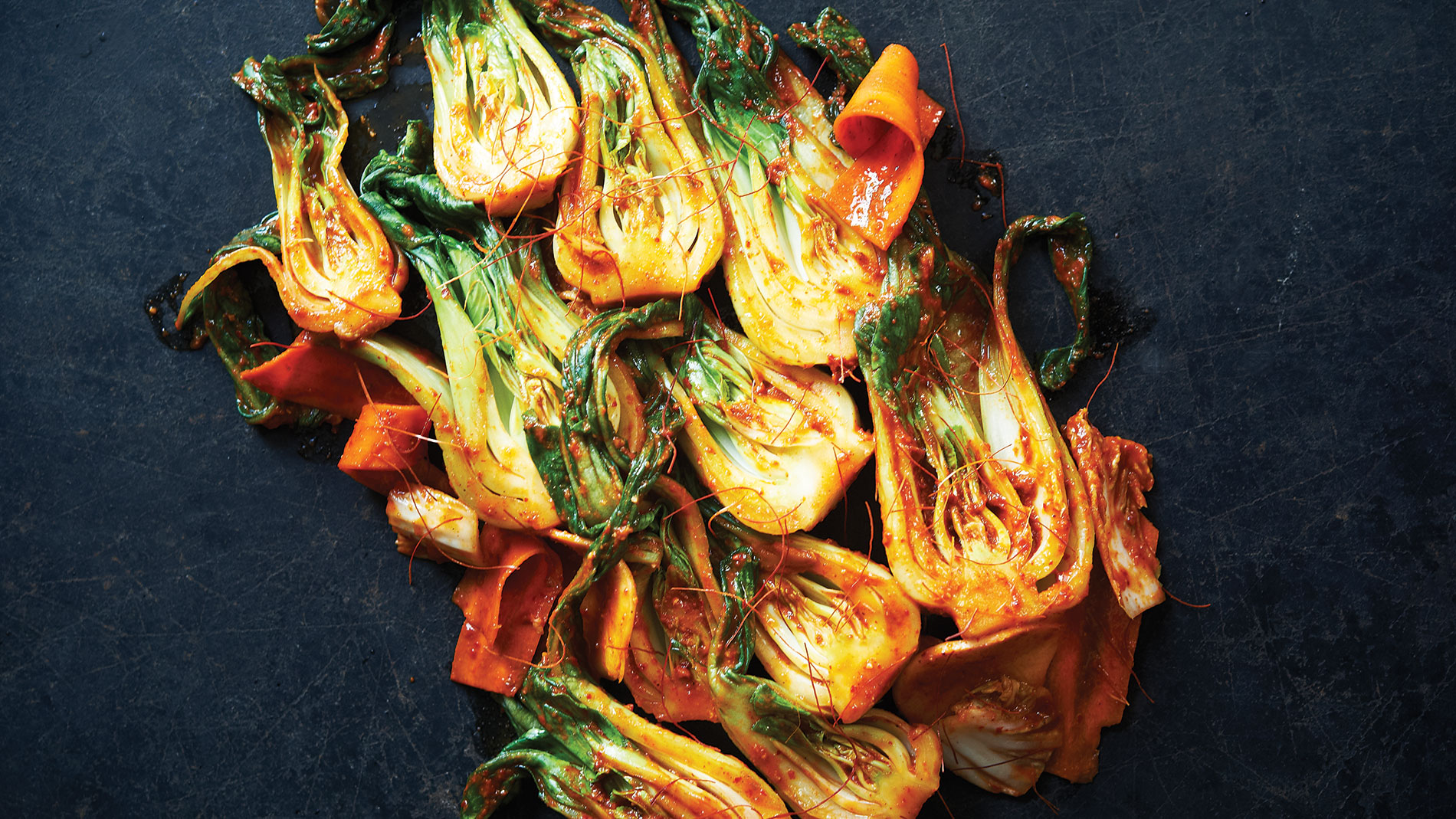Kimchi is trending in St. Louis restaurants
In the worlds of food and fashion, style is cyclical. It seems as though any trend, however strange and antiquated, eventually makes its way back into the spotlight. And kimchi, one of the most surprising restaurant trends du jour, has been waiting in the wings for centuries.
Considering what kimchi is in its simplest form – vegetables that have been pickled and then left to ferment – its popularity is baffling. And yet there it is, on the table at such highly acclaimed restaurants as New York’s Momofuku, San Francisco’s Benu and Chicago’s Girl & the Goat. In St. Louis, it’s hitting menus of all shapes and sizes: the leather-bound ones propped up on white tablecloths and the laminated ones atop a pub bar; the kind that get printed daily for a pop-up and the kind that get taped into the window of a food truck. There’s no doubt about it: This strong-smelling, funky-flavored condiment has arrived.

Kimchi’s definitive origins are unclear, though the earliest documentation of pickled radishes dates back to 12th-century Korea. Kimchi was first made as a way to preserve the bounty of fresh cabbage that was available in abundance during Korea’s harvest each fall. Later, chiles were introduced to the mix, creating the spicy flavor profile often associated with the dish today. In Korea, kimchi is traditionally served with every meal as part of the “banchan” – side dishes that also include soy-bean paste, steamed eggs and gochujang, a spicy chile paste that’s also making a name for itself in American kitchens right now. There are hundreds of ways to make kimchi – with garlic, salt and hot chile paste for red-hot styles that make your tongue tingle with spice, or with flavored vinegars and bean paste for milder versions – or with dozens of other ingredients for the myriad flavor profiles in between. “[Kimchi] complements every Korean dish so well and also serves as a great palate cleanser,” explained David Choi, chef-owner of Seoul Taco. At his food truck and new restaurant in The Loop, Choi serves his version of his Korean grandmother’s kimchi – cool-to-the-touch, hot-to-the-taste finely shredded cabbage – sautéed into fried rice or stuffed inside a burrito, along with lettuce, cheese, carrots, sour cream and your choice of pork, chicken, tofu or bulgogi-marinated steak.

Kimchi’s rebirth isn’t limited to Korean-fusion eateries, though. Chefs all over town are using kimchi’s sharp bite as a foil to richer elements on the plate. At Farmhaus, kimchi joins ginger-mint porchetta – a heavy-handed, savory pork roast – alongside the type of fluffy buns that put Momofuku’s David Chang on the map. For chef de cuisine Andrew Jennrich, kimchi is the perfect counterpart to the dish’s luxurious elements: The deeply flavorful veggies lighten the weightiness of the fatty porchetta with nice crunch and a little heat. Executive chef Rex Hale works similar wonders at 360, where cucumbers and kimchi counter the rich barbecued pork that gets tucked into tacos. For his chicken-themed pop-up restaurant Le Coq, chef John Perkins transformed his house-made kimchi into a ruby red sauce that was sweet, spicy, slightly sour and smooth as satin. He then swept an artful brushstroke of the good stuff around chunky sea scallops that were hugged tightly by crispy chicken skin. At Five Bistro, house-made Napa cabbage and daikon radish kimchi gets paired with Tempura beef liver, pickled shiitake mushrooms and onion grass. Chef-owner Anthony Devoti then drizzles a little soy reduction and dots some soy aioli on the plate before topping things off with a nod to decadence: the quivering, sun-orange yolk of a duck egg. Last fall, Michael Miller, executive chef at Dressel’s Public House, was putting his own twist on kimchi’s roots, replacing traditional Napa cabbage with Brussels sprouts, carrot and daikon radish, creating a familiar vegetable that boasted a spicy-hot, sour crunch that diners didn’t expect. It’s an unexpected flavor profile chef Chris Bork also uses on the menu at Blood & Sand, where he pairs a sweet apple and daikon radish kimchi with tender veal sweetbreads and a savory Brussels sprout slaw.

This bridge between the familiar and the unfamiliar – infusing foreign flavors into approachable dishes that put diners at ease and then turning around and putting their taste buds to the test – may just be the impetus behind kimchi’s modern day revival. It took Choi about six months to put kimchi on Seoul Taco’s menu, worried that the diners lining up for his spicy pork-topped tacos weren’t ready for kimchi’s infamous funk. But while he admitted that the strong smell still repels some customers, it appears local palates have taken to this ancient-meets-modern trend: He regularly fields requests to add it to other entrees. Choi credited an unprecedented awareness of cultural cuisines with diners today. “People might have before unconsciously categorized Korean cuisine as Chinese or Japanese, but the flavor profiles you get from Korean food [are] totally different,” he explained. He’s right. The crunchy, salty stealth heat of this fermented dish is a flavor profile unlike any other in Asian cuisine.

Or maybe kimchi is just the next step in the ever-growing DIY renaissance pulsing through our restaurants today. Bork has been pickling fresh veggies since Blood & Sand opened its doors in 2011, and Farmhaus’ chef-owner Kevin Willmann has been known to spend late nights in the kitchen canning chow-chow – a vegetable and pickle relish spiked with mustard. An endless drive to create and a little brainstorming later, and it isn’t hard to see how fermentation became the new experiment.
Also helping kimchi’s cause is the fact that it carries definite health benefits, as the fermented culture produces the healthy bacteria that aids in digestion. “People are more conscious about what they are eating these days and are discovering the medicinal properties of fermented foods such as kimchi,” Miller explained. “Not to mention it has a unique and exciting effect on the palate.”
And that’s just the point: We may never know what first landed kimchi on this side of the Mississippi, but there’s no denying the role it’s playing in our cuisine. As this funky, foreign pickle pushes our palates clear out of their comfort zones, it’s simultaneously opening the imaginations of the chefs whose passion fuel the future of our culinary scene. “How awesome is it,” noted Jennrich, “that rotting cabbage has become something so totally cool?”
Tags : Places, Restaurants







